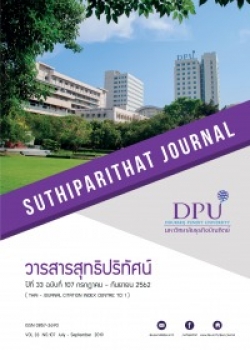การศึกษาองค์ประกอบสุขภาวะของผู้ให้คำปรึกษาสำหรับครูแนะแนว
คำสำคัญ:
การวิเคราะห์องค์ประกอบ, ครูแนะแนว, สุขภาวะของผู้ให้คำปรึกษาบทคัดย่อ
การวิจัยครั้งนี้มีวัตถุประสงค์เพื่อศึกษาองค์ประกอบสุขภาวะของผู้ให้คำปรึกษาสำหรับครูแนะแนว กลุ่มตัวอย่างเป็นครูแนะแนวในโรงเรียนมัธยมศึกษา สังกัดสำนักงานคณะกรรมการการศึกษาขั้นพื้นฐาน กระทรวงศึกษาธิการ ปีการศึกษา 2559 จำนวน 500 คน โดยการสุ่มแบบหลายขั้นตอน เครื่องมือที่ใช้ในการเก็บข้อมูลครั้งนี้ เป็นแบบสอบถามสุขภาวะของผู้ให้คำปรึกษาสำหรับครูแนะแนว ซึ่งมีค่าความเชื่อมั่นเท่ากับ 0.96 สถิติที่ใช้ในการวิเคราะห์ข้อมูลคือ การวิเคราะห์องค์ประกอบเชิงยืนยัน ผลการวิจัยพบว่า โมเดล การวัดสุขภาวะของผู้ให้คำปรึกษาสำหรับครูแนะแนวที่ผู้วิจัยสร้างขึ้นตามแนวคิดของเอลิซาเบธและคณะ ประกอบด้วย 4 องค์ประกอบ ได้แก่ 1. ด้านสุขภาวะทางกาย 2. ด้านสุขภาวะทางอารมณ์ 3. ด้านสุข ภาวะทางการรู้คิด และ 4. ด้านสุขภาวะทางด้านสัมพันธภาพระหว่างบุคคล มีค่าความสอดคล้องกลมกลืนกับข้อมูลเชิงประจักษ์ (χ2 =61.70, df=66, p=.62, GFI=0.98, AGFI=0.97, CFI=1.00, RMSEA=0.00, SRMR=0.02) มีน้ำหนักองค์ประกอบมาตรฐานอยู่ในเกณฑ์สูง มีค่าระหว่าง 0.92 – 0.99 มีนัยสำคัญทางสถิติที่ระดับ .01 และมีค่าความเชื่อมั่นเชิงโครงสร้างอยู่ระหว่าง 0.85 – 0.98 ดังนั้น จึงแสดงให้เห็นว่าโมเดลการวัดสุขภาวะของผู้ให้คำปรึกษาสำหรับครูแนะแนวที่ผู้วิจัยสร้างขึ้น สามารถนำมาอธิบายสุขภาวะของผู้ให้คำปรึกษาสำหรับครูแนะแนวได้ โดยสามารถเรียงลำดับค่าน้ำหนักองค์ประกอบได้ดังนี้ ด้านสุขภาวะทางการรู้คิด (0.99) มีค่าน้ำหนักองค์ประกอบมากที่สุด รองลงมาคือ ด้านสุขภาวะทางกาย (0.97) ด้านสุขภาวะด้านสัมพันธภาพระหว่างบุคคล (0.95) และด้านสุขภาวะทางอารมณ์ (0.92) ตามลำดับ
เอกสารอ้างอิง
กลุ่มสารสนเทศ สำนักงานนโยบายและแผนการศึกษาขั้นพื้นฐาน. (2558). ข้อมูลโรงเรียนมัธยมสังกัด สมป. ปี 2558. สืบค้น 31 มีนาคม 2559, จาก https://www.bopp-obec.info/home/?page_id=18308.
ชูศรี วงศ์รัตนะ. (2558). เทคนิคการเขียนเค้าโครงการวิจัย: แนวทางสู่ความสำเร็จ (ฉบับปรับปรุง) (พิมพ์ครั้งที่ 3). กรุงเทพฯ: อมรการพิมพ์.
บุญโรม สุวรรณพาหุ. (2557). ผลของกลุ่มการปรึกษาเชิงจิตวิทยาแนวความหมายในชีวิตต่อการเปลี่ยนแปลงของ สุขภาวะในเยาวชนผู้กระทำผิดที่ใช้สารเสพติดที่มีระดับการควบคุมตนเองแตกต่างกัน (ปริญญานิพนธ์ ศึกษาศาสตรดุษฎีบัณฑิต). กรุงเทพฯ: จุฬาลงกรณ์มหาวิทยาลัย.
พนม ลิ้มอารีย์. (2533). การแนะแนวเบื้องต้น. กรุงเทพฯ: โอเดียนสโตร์.
สงวน สุทธิเลิศอรุณ. (2530). สัมมนาปัญหาการแนะแนว. กรุงเทพฯ: อักษรบัณฑิต.
อรวิไล สว่างคำ. (2548). คู่มือการปฏิบัติงาน: การจัดบริการแนะแนวระดับประถมศึกษา สำนักงานคณะกรรมการการศึกษาเอกชน จังหวัดปทุมธานี (ปริญญานิพนธ์การศึกษามหาบัณฑิต). กรุงเทพฯ: มหาวิทยาลัยศรีนครินทรวิโรฒ.
อุษณีย์ เย็นสบาย. (2548). จิตวิทยาแนะแนว. กรุงเทพฯ: โอเดียนสโตร์.
Ardell, D. B. (1988). Planning for wellness: A commitment to personal excellence (3rd ed.). Dubuque, Iowa: Kendall/Hunt Publishing.
Burck, M. A. (2014). Emerging counselors’ perception of wellness implications for counselor development. Counseling Outcome Research and Evaluation, 5(1), 39-51. Retrieved February 14, 2016, from https://cor.sagepub.com/content/5/1/39.full.pdf+html.
Chapple, Iain., Mealey, B. L., Van Dyke, T. E., Bartold, P., Dommisch, H., Eickholz, Peter., … Shapira, L. (2018). Periodontal health and gingival diseases and conditions on an intact and a reduced periodontium: Consensus report of workgroup 1 of the 2017 World Workshop on the Classification of Periodontal and Peri-Implant Diseases and Conditions. Journal of Clinical Periodontology, 45 (Suppl20), S68–S77. Retrieved September 21, 2018, from https://doi.org/10.1111/jcpe.12940.
Curry, J. R. (2007). An investigation of the relationship between counseling self-efficacy and counselor wellness among counselor education students. Orlando: University of Central Florida. Retrieved February 2, 2016, from https://search.proquest.com/docview/304743455.
Elizabeth, V., Sonya, V., & Heather, P. (2007). What individual counselors can do to sustain wellness. Journal of Humanistic Counseling, Education, and Development, 46, 50-65.
Foster, L. H., Young, J. S., & Hermann, M. H. (2005). The work activities of professional school counselors: Are the national standards being addressed? Professional School Counseling, 8(4), 313-321.
Hair, J., Black, W.C., Babin, B.J., & Anderson, R.E. (2010). Multivariate data analysis (7thed.). Upper saddle River, New Jersey: Pearson Education International.
Hettler, B. (1984). Wellness: Encouraging a lifetime pursuit of excellence. Health Values: Achieving High Level Wellness, 8(4), 13-17.
Hollingsworth, M. A. (2015, June). Wellness as a framework for counselor education and college student intervention. Hawaii University International Conferences, 1-15.
Maslow, A. H. (1971). The father reaches of human nature. New York: Viking Press.
Myers, J. E., Sweeney, T. J., & Witmer, J. M. (2000). The wheel of wellness counseling for wellness a holistic model for treatment planning. Journal of Counseling & Development, 78(3), 251-266.
Myers, R. A., & Sweeney, T. J. (2005). Manual for the five factor wellness inventory. Mindgarden Publishers, Inc.
Rayle, A. D. (2006). Do school counselors matter? Mattering as a moderator between job stress and job satisfaction. Professional School Counseling, 9(3), 206-215.
Roach, L. (2005). The influence of counselor education programs on counselor wellness. Orlando: University of Central Florida. Retrieved February 2, 2016, from https://search.proquest.com/docview/250860489/previewPDF/A241D00ACF4941C3PQ/1?accountid=44800.
Schumacker, R. E., & Lomax, R. G. (2010). A beginner’s guide to structural equation modeling. New York: Routledge.
Sell, Anna., Walden, Camilla., & Walden, Pirkko. (2017). My wellness as a mobile app. identifying wellness types among the young elderly. Hawaii International Conference on System Sciences, 1473-1482. Retrieved September 21, 2018, from https://scholarspace.manoa.hawaii.edu/handle/10125/41330.
Shillingford, M. A. (2013). Wellness of minority female counselor educators. Counselor Education and Supervision, 52(4), 255-269. Retrieved February 8, 2016, from https://eds.b.ebscohost.com/ehost/pdfviewer/pdfviewer?sid=529fec63-d60c-4351-aed0-3de9e01d51d8%40sessionmgr103&vid=1&hid=127.
Stevanovic, P., & Rupert, P. A. (2004). Career-sustaining behaviors, satisfactions, and stresses of professional psychologists. Psychotherapy: Theory, Research, Practice, Training, 41(3), 301-309.
Street, S. (1994). The school counselor practices wellness. School Counselor, 4(3), 171-180.
Ursula, E. O., & Alan, E. S. (2003). Advancing theory in therapy. USA: Brunner-Routledge.
Webb, L. D., Brigman, G. A., & Campbell, C. (2005). Linking school counselors and student success: A replication of the student success skills approach targeting the academic and social competence of students. Professional School Counseling, 8(5), 407-413.
Williams, M. B., & Sommer, J. F. (1995). Self-care and the vulnerable therapist. In B. H. Stamm (Ed.). Secondary traumatic stress (pp. 232-246). Lutherville. MD: Sidran Press.
Wolf, C. P., Thompson, I. A., Thompson, E. S., & Smith-Adcock, S. (2014). Refresh your mind, rejuvenate your body, renew your spirit: A pilot wellness program for counselor education. The Journal of Individual Psychology, 70(1), 57-75.
ดาวน์โหลด
เผยแพร่แล้ว
รูปแบบการอ้างอิง
ฉบับ
ประเภทบทความ
สัญญาอนุญาต
เนื้อหาและข้อมูลในบทความที่ลงตีพิมพ์ในวารสารสุทธิปริทัศน์ ถือเป็นข้อคิดเห็นและความรับผิดชอบของผู้เขียนบทความโดยตรงซึ่งกองบรรณาธิการวารสาร ไม่จำเป็นต้องเห็นด้วย หรือร่วมรับผิดชอบใด ๆ
บทความ ข้อมูล เนื้อหา รูปภาพ ฯลฯ ที่ได้รับการตีพิมพ์ในวารสารสุทธิปริทัศน์ ถือเป็นลิขสิทธิ์ของวารสารสุทธิปริทัศน์หากบุคคลหรือหน่วยงานใดต้องการนำทั้งหมดหรือส่วนหนึ่งส่วนใดไปเผยแพร่ต่อหรือเพื่อกระทำการใด ๆ จะต้องได้รับอนุญาตเป็นลายลักษณ์อักษรจากวารสารสุทธิปริทัศน์ก่อนเท่านั้น







